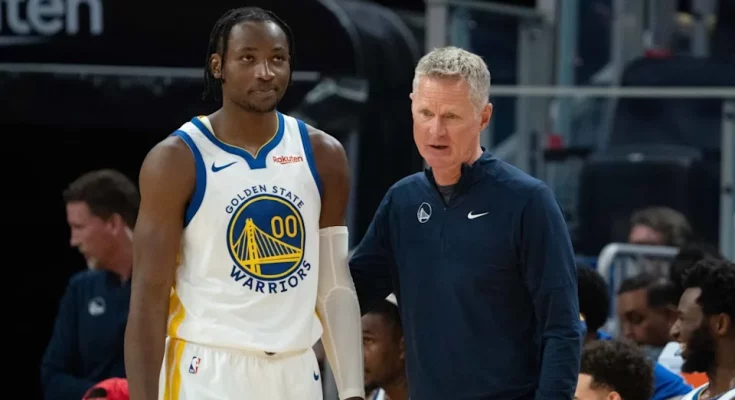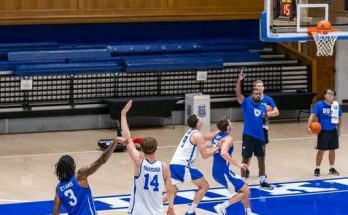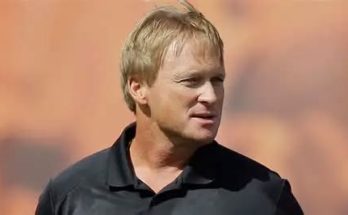The Golden State Warriors have long been heralded as the NBA’s model of success—a dynasty built on the brilliance of Stephen Curry, the defensive tenacity of Draymond Green, and the selflessness of Klay Thompson. But in recent years, as the Warriors try to navigate the challenging transition from their aging championship core to a more youthful future, tension has bubbled beneath the surface. The latest firestorm surrounds Jonathan Kuminga, the supremely talented and ultra-athletic forward drafted in 2021, whose development—or lack thereof—has become a lightning rod of controversy within the organization. Now, a former NBA champion has stepped into the conversation, leveling harsh criticism at head coach Steve Kerr and blaming him directly for what they call the mishandling of Kuminga and the long-term cost it might have on Golden State’s future.
The comments come at a time when the Warriors find themselves at a precarious crossroads. The team is aging, expensive, and no longer a lock for deep playoff runs. The hope was that Kuminga, a top-seven pick, would rise through the ranks as a next-generation star capable of leading Golden State into the future once the dynasty winds down. But instead of becoming a cornerstone, Kuminga’s role has been inconsistent, often minimal in critical moments, and lacking the type of runway young players need to truly blossom. Many fans have voiced concern, but when a former champion speaks up, it’s bound to echo more loudly through NBA circles.
The anonymous former NBA champion didn’t hold back, stating that Kerr’s old-school loyalty to veteran players and rigid system has stifled Kuminga’s growth, robbing the Warriors of a golden opportunity to transition into a new era without a full rebuild. “You’ve got a Ferrari in the garage, and you’re taking the bus,” the player said. “That’s what’s going on with Kuminga. He’s got all the tools—speed, power, athleticism, even a developing jumper. But Kerr won’t give him the keys. That’s not just bad coaching—it’s bad vision.”
The comment speaks to a growing faction within the NBA community that believes Steve Kerr’s strengths as a coach are also his greatest weakness. He has famously relied on ball movement, veterans’ savvy, and championship continuity, all of which have led to banners in the rafters. But in the modern NBA, development and flexibility are crucial. With young talent sprouting across the league—players like Anthony Edwards, Scottie Barnes, and Paolo Banchero being handed the reins early and thriving—Kuminga’s stunted usage feels more and more like a misstep.
What’s more frustrating for many is that Kuminga has flashed brilliance when given opportunities. He’s shown the ability to defend multiple positions, explode in transition, and score in bunches. His per-36 numbers are often eye-popping, revealing a player who, if granted starter minutes, could easily average north of 20 points per game while contributing on both ends of the floor. But Kerr’s insistence on fitting players into pre-existing systems rather than adapting systems to players has left Kuminga frustrated—and now possibly on the brink of becoming another “what-if” story in the NBA.
Internal reports suggest that Kuminga’s camp has already voiced dissatisfaction, particularly during last season’s playoff run when he was benched for long stretches while older, slower players took his minutes and produced middling results. Sources close to the team say that there was tension behind closed doors, with Kuminga questioning whether the organization truly valued his development or merely saw him as a trade chip to extend the veteran era.
The irony, of course, is that Kerr once benefited from a young player being empowered. Back in 2015, he entrusted then relatively unproven players like Draymond Green to take on huge roles, even benching veteran David Lee to allow Green to thrive. That bold decision helped unlock a dynasty. But now that he’s steering the ship years later, it seems Kerr has grown more conservative, leaning too heavily on familiarity and not enough on upside.
Golden State’s front office, led by Mike Dunleavy Jr., now finds itself in a difficult position. On one hand, Kuminga’s value is still high; he’s young, explosive, and shows flashes of stardom. On the other hand, he hasn’t been showcased enough to extract maximum return in a trade. Worse still, if they do decide to move him, they may be trading away the one player capable of carrying the torch from the Curry era without having truly seen what he can become.
The stakes couldn’t be higher. The Warriors’ future hinges on whether they can gracefully evolve without blowing everything up. Keeping Kuminga and investing in his growth would represent a bet on youth and internal development. Trading him would signal a doubling down on the old guard, which has already shown signs of breaking down physically and competitively. Kerr’s unwillingness to adapt could ultimately cost Golden State both timelines—the present and the future.
Even around the league, the situation is being closely watched. Multiple teams are reportedly monitoring Kuminga’s situation, ready to pounce if Golden State decides to move him. One executive from an Eastern Conference team even stated, “If he becomes available, 20 teams will line up with offers. He’s that good. The only thing stopping him is opportunity.” That’s a scathing indictment not of the player, but of how he’s being used.
While Kerr’s résumé speaks for itself—multiple championships, Team USA coaching responsibilities, and wide respect among peers—the modern NBA is a different beast. The days of playing nine-deep with seven 30-somethings are over. Player development, adaptability, and calculated risk-taking have become essential tools for sustained success. If Kerr doesn’t adjust, he may risk becoming a victim of his own legacy.
There’s also a psychological component at play. Kuminga, like many young players, needs trust and validation. Benching him in key moments sends a message—intentional or not—that the coaching staff doesn’t fully believe in him. That can erode confidence and, over time, fracture the player-coach relationship. Already, whispers around the league suggest that Kuminga’s patience is wearing thin. If Golden State doesn’t provide clarity on his role soon, the bridge may become too damaged to repair.
Fans have taken to social media in droves, backing Kuminga and criticizing Kerr for what they see as outdated decision-making. Posts comparing Kuminga’s production per minute to other breakout stars have gone viral, with many concluding that he’s being chronically underutilized. The Warriors’ identity, once marked by innovation and forward-thinking, now risks being perceived as rigid and out of touch.
What makes this situation even more complicated is the presence of Steph Curry. As long as Curry is on the roster and in his prime—even if only for another couple of years—there’s an expectation that the Warriors will compete for championships. That win-now mentality often clashes with the patience required for young player development. Kerr, understandably, wants to maximize what’s left of Curry’s window. But the cost of doing so could be mortgaging the future entirely.
Therein lies the dilemma. How do you honor a legend like Curry while preparing for life after him? The answer may lie in striking a balance—using the regular season to give Kuminga and other young players more responsibility, while relying on the veterans when it counts. But that requires Kerr to evolve his approach and trust that growth through experience is just as valuable as execution through repetition.
Whether or not Kerr makes that leap remains to be seen. But the former NBA champion who spoke out is not alone in his concerns. Across the league, executives, coaches, analysts, and fans alike are wondering if the Warriors’ coach is standing in the way of the franchise’s next chapter. If so, the cost may not just be a season or a player—it could be the collapse of a legacy built on vision, trust, and the courage to take bold chances.
Jonathan Kuminga still has time. He’s young, talented, and reportedly still committed to succeeding in the league, whether in Golden State or elsewhere. But time is also running short. The NBA moves fast, and opportunities don’t linger forever. The Warriors have a choice to make—one that will define not just Kuminga’s future, but their own. Whether Kerr is the coach to lead that next evolution is now a question echoing louder than ever through the halls of Chase Center.



